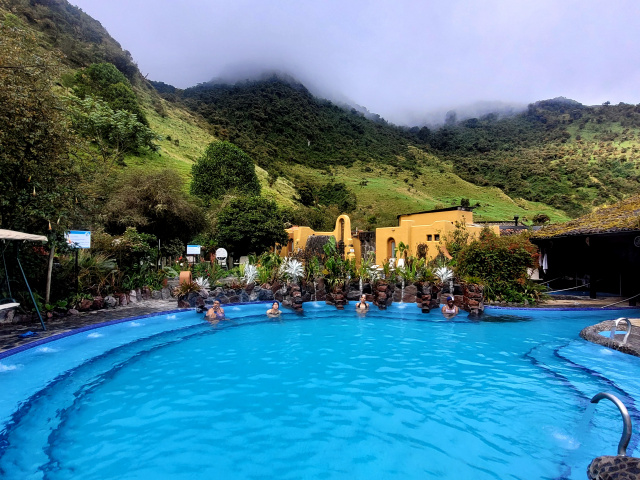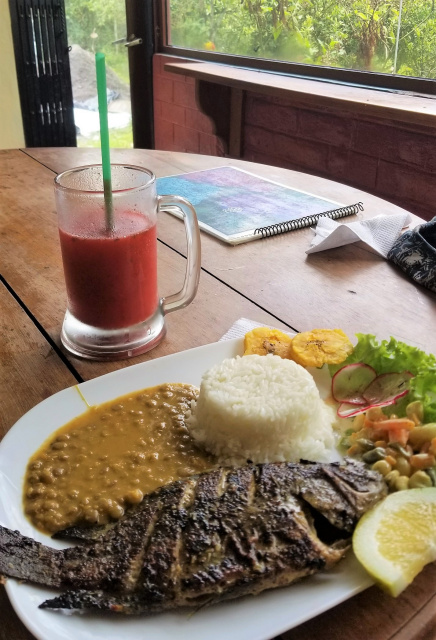
Papallacta Hot Springs
High in the lush cloud forest of the Andes mountains are a small town called Papallacta. Here we will visit a hot spring resort that has a series of hot spring pools surrounded by cow grassed mountain slopes, hummingbirds, and tropical flowers.
You will find a series of pools with water of varying temperatures and unlike most natural hot pools, there is little to no sulfur smell around the pools. You will have amble time to soak in the pools and enjoy the beautiful natural surroundings.
Tour End
Our tour will end at Quito Mariscal Sucre Airport (UIO) on Sun June 18th at 4:15 am, if you are booking a later flight than the American Airlines #932 at 6:39 am, you can take an Uber or a taxi from the hotel (Check out time 12 noon), it is about 12 minutes’ drive to the airport.
PRACTICAL INFO
Accommodation
We will stay in 4 different comfortable 2-3-star hotels during the whole trip, you will always have a private bathroom and all places will have free Wifi.
Guides
You will have one English speaking tour leader joining you from the airport in NYC and in Ecuador you will have additional local English/Spanish speaking tour guide.
Food and Water 
Eating local is a big part of traveling and provides an important insight into local ways of life. To give you the maximum flexibility in deciding where, what and with whom you eat, we have chosen not to include all meals. This will also give you more budgeting flexibility. South American food is delicious, nutritious and varied and most places there usually are quite a few options of restaurants to choose from, but sometimes we will be in more rural areas where options will be more limited. Photo here is a typical Ecuadorian lunch. To avoid any getting sick from eating food, it is advised that you only eat cooked food.
Fruits and vegetables are safe to eat in Ecuador, but it’s important to remember that water isn’t safe to drink, and fruits and vegetables can make you sick if they were washed with contaminated water. If you buy fruit, wash it yourself with purified water, and make sure to carefully peel the skin. The same goes for vegetables. Do not eat salad from a restaurant, unless the restaurant explicitly states that they wash their raw vegetables in decontaminated water. It is always a good idea to bring an antacid (like Tums) with you.
Do not drink the tap water anywhere in Ecuador. Only drink bottled or boiled water or soft drinks.
Be careful of fruit juices – they’re often diluted with water. They can also be mixed with milk, which may be unpasteurized. Ice cubes are typically made from tap water, so make sure to ask for your drink without ice.
Food Included in price
Day 1: None
Day 2: Breakfast and Lunch
Day 3: Breakfast and Lunch
Day 4: Breakfast and Lunch
Day 5: Breakfast and Lunch
Day 6: Breakfast and Lunch
Day 7: Breakfast and Lunch
Day 8: Breakfast and Lunch
Day 9: None
Ecuador is in general a lot cheaper than the US when it comes to buying food. Calculate with $100 - $200 for meals not included. Dependent on your eating habits, could be a bit less or a bit more.
Weather
Since Ecuador is situated along the earth’s equator, the temperature is fairly consistent throughout the year, but does vary by region. Higher-elevation areas like Quito and Cotopaxi volcano can get chilly, so you’ll want to pack warmer clothes. Quito has an average daily temperature of 70 degrees during the day and about 50 at night. The Amazon region will be the warmest part of our tour here we can expect temperature around the mid 80’s.
Spending Money
You need to bring enough money to cover meals not included in the price ($100 - $200), drinks, tips, incidentals and souvenirs. Ecuador is more of a cash society than the US. Ecuador uses the US dollar as currency and the country tends to be less expensive than the US. If you decide to pay on a local market with a $20, you can count on that they won’t have change, so it is always a good idea to bring a lot of single dollar bills.
Altitude
Quito is the second-highest capital city in the world. With an altitude of 9,350 ft above sea level, Only La Paz in Bolivia is at higher elevation. This mean that the views are stunning, but the altitude can also cause some headaches – literally! – as the higher up you are, the less oxygen goes to your lungs with every breath. But most likely you will probably experience nothing worse than some shortness of breath, though a few people also suffer headaches, dizziness, and nausea.
Staying hydrated is one of the most important acclimatization tips. Your body in the elevation works harder; it needs more water because it also uses more water. If you’re a smoker, consider taking a break from the cigarettes during your time in Quito and other places that we will visit with similar elevations.
Another way to fight altitude sickness is by enjoying a diet rich in carbs. We are not talking about chips; the best strategy is to eat some light meals that contain carbs and add plenty of fruit and green vegetables.
There are some medicine’s that can used to reduce the symptoms of altitude sickness, Ibuprofen (Advil, Motrin, Aleve) is one of them, and there are some medicine’s that can prevent you getting altitude sickness as well. In Ecuador there is medicine called Diamox or Glaucomed, that helps fight the symptoms of altitude sickness. Don’t forget to consult with your doctor about these medicines before traveling to Ecuador.
Visa
If you are a US citizen, you will not be required to apply for and acquire a visa beforehand. Once you enter the country, you will be granted a free 90-day tourist visa. Ecuador requires that all travelers entering the country have a passport that are valid for up to six months from the date that you are flying back home again. This is very important, otherwise you will not be allowed to enter the country. We recommend that you also bring copies of all your important documents, and maybe even email them to you self.
Electricity/Plugs
Ecuador uses the same electricity 110 volts, 60 cycles AC as in the US, and plugs/outlets are also the same.
Vaccines
The CDC does recommend some vaccines for the areas that we will be visiting in Ecuador. CDC strongly recommends that you are up to date with your Covid-19 vaccine. For the specific areas that we will be doing activities in the CDC also recommend a vaccine for Yellow Fever, but only recommend mosquito avoidance for Malaria, but not necessary taking medicine. Please consult with your doctor before leaving and please take your time and read more about the CDC’s recommendations here:
https://wwwnc.cdc.gov/travel/destinations/traveler/none/ecuador
Travel Health Insurance
We do require that you have a travel health insurance for this tour, to cover for medical emergencies. Cancellation/interruption insurance is optional. Check if your regular health insurance cover out of country, if so then you don’t need to purchase a separate insurance unless you want Cancellationor/interruption to be covered as well. We can recommend www.insuremytrip.com or www.squaremouth.com (Hines Tours is not affiliated with this site in any form) here you should be able to find a travel medical health insurance for 9 days in Ecuador for about $25-35.
Security and Safety
While Ecuador is a relatively safe country, it never hurt to keep a careful eye on your belongings. Like many countries, pickpocketing and other petty crimes can be a problem, particularly in large cities such as Quito. We strongly recommend the use of a neck wallet worn close to your body or a money belt while traveling, for the safe keeping of your passport, credit cards, cash and other valuable items. Leave your valuable jewelry at home - Wearing jewelry and expensive watches will only attract attention. A lock is recommended for securing your luggage. DO NOT leave any valuables in ANY hotel room, if available use safety deposit boxes. You are solely responsible for your own valuables. We also recommend that you keep your cash in several different places on yourself. A lot of pickpocketing happens on public transportation, one good thing is that we will only be traveling in a private vehicle during the whole trip. But extra caution is advice when visiting markets etc.
The U.S. government does warn against visiting the northern region of Ecuador towards the Columbian border, we will NOT be visiting this region.
Ecuador Suggested Packing List
BAGS: We recommend that you only bring a carry-on bag (Please check size restrictions with your airline) and one personal item which has to fit underneath the seat in front of you. (We highly recommend that as a personal item you bring a backpack you can use for our day tours (Please check size restrictions with your airline). Since we have limited space in our transportation vehicle, we suggest that you don’t bring more than that. If you feel the need to bring a bag to check in (up to 50 pounds) you will most likely have to pay an extra fee each way. For your carry-on bag, please make sure that any liquids containers are limited to 3.4 ounces (100 ml)
DOCUMENTS
□ A valid passport, must be valid for 6 months after the return date
□ Health Insurance papers/card (your regular plan and/or supplemental travel health insurance plan)
□ Copies of any prescriptions (Make sure prescriptions include generic names. Bring prescriptions for medicines, eye glasses/contacts, and other medical supplies)
CLOTHES
Dress in layers, we will probably experience temperatures from 45 to 85 degrees.
□ Underclothes and socks
□ T-shirts
□ Sweaters
□ Light / Fall Jacket
□ Hiking Pants
□ Shorts
□ Swimsuit + Flip Flops
□ Hiking Boots / Sneakers with good traction
□ Rain Gear
□ Hat
ELECTRONICS
□ Phone and charger
□ Camera, charger and maybe extra memory & Battery
MEDICATION
□ Allergy medicine if needed
□ Pain relievers
□ Motion sickness medicine if needed
□ Altitude sickness medicine
□ Anti diarrhea medicine
□ Mild laxative
□ Any prescribed medication
□ Small first aid kit, could include: hydrocortisone cream, Antifungal and Antibacterial ointments, Antiseptic wound cleanser, Aloe gel for sunburns, Anti-itch gel for insect bites, Band-aids/Bandages, Disposable gloves, Scissors and safety pins, Cotton swabs, Tweezers and Eye drops
TOILETRIES
□ Toothbrush and Toothpaste
□ Travel-sized lotion, shampoo, and body wash
□ Contact lens case and solution
□ Hand Sanitizer
MISCELLANEOUS
□ Insect repellant
□ Sunglasses and Sun Screen
□ Ear plugs
□ Towel
□ Cash and Credit Card
MULTI DAY FLYING TOURS Cancellation Fees (Per Person)
30 days or more before departure - Loss of deposit
15 – 29 days before departure - 50% of tour price
14 days or less before departure - No refund or tour credit.
|